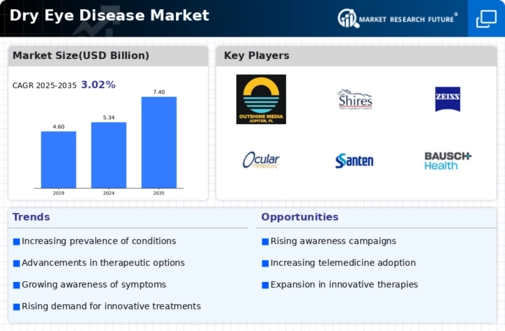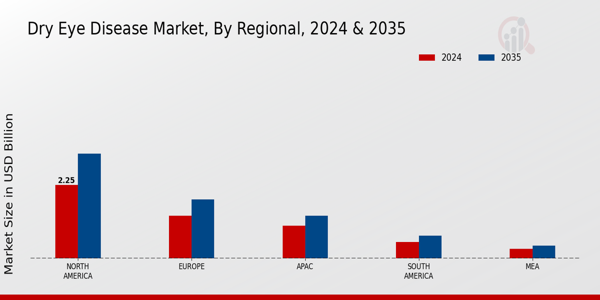Market Growth Projections
The Global Dry Eye Disease Market Industry is poised for substantial growth, with projections indicating a market value of 5.34 USD Billion in 2024 and an anticipated increase to 7.4 USD Billion by 2035. This growth trajectory reflects a compound annual growth rate of 3.01% from 2025 to 2035, driven by various factors including increasing prevalence, advancements in treatment options, and rising awareness. The market dynamics suggest a robust future, with opportunities for innovation and expansion across different regions.
Rising Awareness and Diagnosis
Increased awareness regarding dry eye disease is fostering growth within the Global Dry Eye Disease Market Industry. Public health campaigns and educational initiatives are encouraging individuals to seek diagnosis and treatment. This heightened awareness is reflected in the growing number of patients diagnosed with dry eye conditions, which in turn drives demand for therapeutic solutions. As healthcare providers become more adept at recognizing symptoms, the market is likely to experience a compound annual growth rate of 3.01% from 2025 to 2035, indicating a robust trajectory fueled by improved diagnostic practices.
Impact of Environmental Factors
Environmental factors, including pollution and prolonged screen time, are contributing to the rising incidence of dry eye disease, thereby impacting the Global Dry Eye Disease Market Industry. Urbanization and lifestyle changes have led to increased exposure to irritants and allergens, exacerbating dry eye symptoms. For instance, studies suggest that individuals who spend extended periods on digital devices are more prone to developing dry eye conditions. This trend underscores the necessity for effective management strategies and products, propelling market growth as consumers seek relief from environmental triggers.
Advancements in Treatment Options
Innovations in treatment modalities are significantly influencing the Global Dry Eye Disease Market Industry. The introduction of novel therapies, including anti-inflammatory medications and advanced lubricants, enhances patient outcomes. For example, the development of prescription eye drops that target inflammation has shown promising results in clinical trials. Such advancements not only improve the quality of life for patients but also stimulate market growth. As the industry evolves, it is anticipated that the market will expand to reach approximately 7.4 USD Billion by 2035, driven by the demand for more effective and diverse treatment options.
Growth of E-commerce in Healthcare
The expansion of e-commerce platforms is reshaping the Global Dry Eye Disease Market Industry by enhancing accessibility to treatment options. Online pharmacies and health retailers are increasingly offering a wide range of dry eye products, making them more accessible to consumers. This trend is particularly relevant in regions where traditional healthcare access may be limited. As e-commerce continues to grow, it is expected to facilitate market penetration, allowing patients to obtain necessary treatments conveniently. This shift could further bolster the market, aligning with the projected growth trajectory.
Increasing Prevalence of Dry Eye Disease
The rising prevalence of dry eye disease is a primary driver for the Global Dry Eye Disease Market Industry. Factors such as aging populations and environmental influences contribute to this increase. For instance, the World Health Organization indicates that the global population aged 60 years and older is projected to reach 2.1 billion by 2050. This demographic shift is likely to elevate the incidence of dry eye conditions, as older individuals are more susceptible. Consequently, the market is expected to grow, with projections estimating a market value of 5.34 USD Billion in 2024, reflecting the urgent need for effective treatments.





















